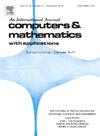Static and vibration analyses of laminated conical shells under various boundary conditions using a modified scaled boundary finite element method
IF 2.5
2区 数学
Q1 MATHEMATICS, APPLIED
引用次数: 0
Abstract
In this paper, a modified scaled boundary finite element method (SBFEM) is developed to study static and vibration behaviors of laminated conical shells under the conical coordinate system. In the modified SBFEM, the geometry of the conical shell is defined entirely by scaling the internal surface of the structure. This approach eliminates geometric errors caused by discretization, thereby enhancing modeling accuracy. The three-dimensional problem is simplified to a two-dimensional analysis since discretization is only applied to the boundary of the computational domain. Additionally, the semi-analytic property of the SBFEM allows for the derivation of a linear analytical solution for the laminated conical shell in the radial direction. First, a scaled boundary coordinate system for the scaling surface is established, and a second-order scaled boundary finite element governing equation with variable coefficients is derived for a single layer of the conical shell using the principle of virtual work. Next, the governing equation is transformed into a first-order system by introducing a combined vector of displacement and nodal force, and the stiffness matrices for each layer of the laminated conical shell are obtained using the precise integration method. Finally, an overall analysis of the laminated structure is conducted by assembling each single-layer structure while considering the continuity boundary condition at interfaces. Static and vibration analyses of laminated conical shells are conducted, and the results are compared with those from the literature to demonstrate the adaptability and convergence of the proposed method. Several numerical examples are presented to examine the effects of various geometric parameters, such as thickness, length, semi-vertex angles, layup directions, and stacking sequences, on the responses of the structure.
使用改进的比例边界有限元法对各种边界条件下的层叠锥壳进行静态和振动分析
本文开发了一种改进的缩放边界有限元法(SBFEM),用于研究锥形坐标系下层叠锥壳的静态和振动行为。在改进的 SBFEM 中,锥壳的几何形状完全由结构的内表面缩放来定义。这种方法消除了离散化带来的几何误差,从而提高了建模精度。由于离散化仅应用于计算域的边界,因此三维问题被简化为二维分析。此外,SBFEM 的半解析特性允许推导出层叠锥壳径向的线性解析解。首先,建立缩放面的缩放边界坐标系,并利用虚功原理推导出锥形壳单层的二阶缩放边界有限元可变系数控制方程。然后,通过引入位移和节点力的组合矢量,将控制方程转化为一阶系统,并利用精确积分法得到层叠锥壳各层的刚度矩阵。最后,在考虑界面连续性边界条件的情况下,通过组装每个单层结构,对层叠结构进行整体分析。对层叠锥壳进行了静态和振动分析,并将结果与文献中的结果进行了比较,以证明所提方法的适应性和收敛性。还给出了几个数值示例,以研究各种几何参数(如厚度、长度、半顶点角、层叠方向和堆叠顺序)对结构响应的影响。
本文章由计算机程序翻译,如有差异,请以英文原文为准。
求助全文
约1分钟内获得全文
求助全文
来源期刊

Computers & Mathematics with Applications
工程技术-计算机:跨学科应用
CiteScore
5.10
自引率
10.30%
发文量
396
审稿时长
9.9 weeks
期刊介绍:
Computers & Mathematics with Applications provides a medium of exchange for those engaged in fields contributing to building successful simulations for science and engineering using Partial Differential Equations (PDEs).
 求助内容:
求助内容: 应助结果提醒方式:
应助结果提醒方式:


